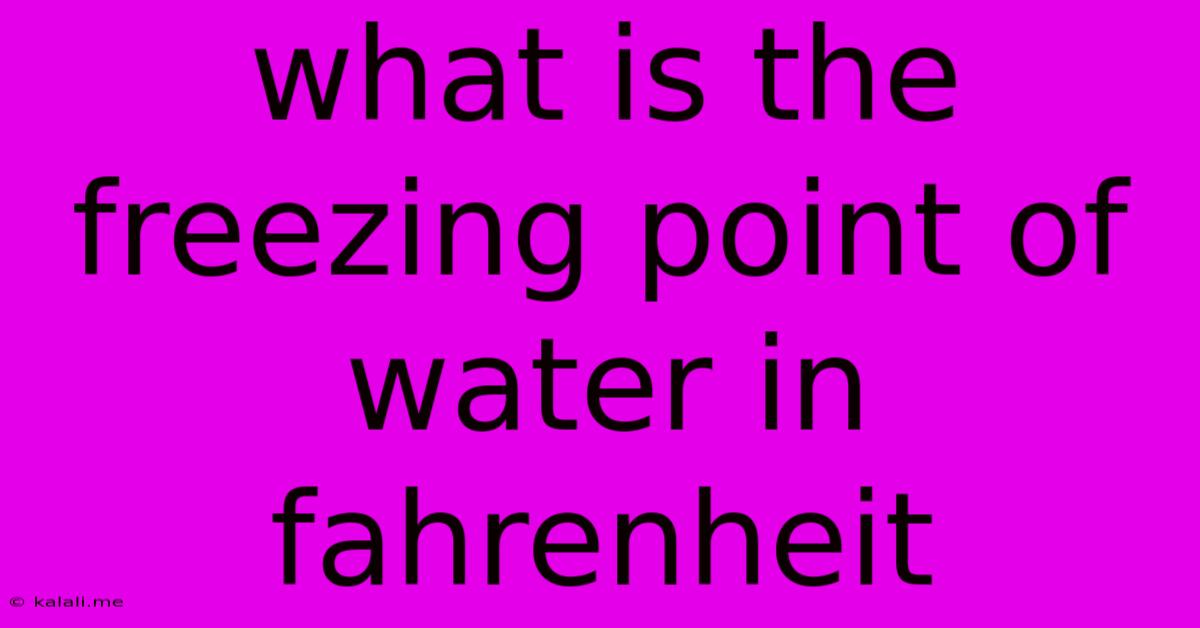What Is The Freezing Point Of Water In Fahrenheit
Kalali
Jun 12, 2025 · 2 min read

Table of Contents
What is the Freezing Point of Water in Fahrenheit?
The freezing point of water in Fahrenheit is 32°F. This is a fundamental fact in science and everyday life, crucial for understanding weather, cooking, and various scientific processes. Understanding this simple conversion is key to interpreting weather reports and navigating various situations where temperature plays a role. This article will delve deeper into this seemingly simple question, exploring related concepts and addressing common misconceptions.
Understanding the Freezing Point
The freezing point of a substance is the temperature at which it transitions from a liquid state to a solid state. For water, this transition involves the molecules slowing down enough to form a stable crystalline structure – ice. This temperature is influenced by factors like pressure and the presence of impurities, but at standard atmospheric pressure, the freezing point of pure water is consistently 32°F.
Fahrenheit vs. Celsius
It's important to distinguish between Fahrenheit and Celsius, the two most common temperature scales. While 32°F marks the freezing point of water, in the Celsius scale, it's 0°C. The difference stems from the different reference points used to define each scale. Fahrenheit uses the freezing and boiling points of a brine solution, while Celsius uses the freezing and boiling points of pure water. This leads to different numerical values for the same temperature.
Practical Applications of Knowing the Freezing Point
Knowing that water freezes at 32°F has numerous practical applications:
- Weather Forecasting: Understanding this allows you to interpret weather reports accurately. Temperatures below 32°F indicate the potential for ice formation, impacting travel and outdoor activities.
- Food Safety: Freezing food at or below 32°F is crucial for food preservation, inhibiting the growth of bacteria and extending shelf life.
- Plumbing: Understanding the freezing point helps prevent frozen pipes during cold weather. Water expands as it freezes, potentially causing pipes to burst if the water within them freezes.
- Scientific Experiments: The freezing point of water serves as a benchmark in many scientific experiments and calculations involving temperature and phase transitions.
Factors Affecting the Freezing Point of Water
While 32°F is the standard freezing point, several factors can influence it slightly:
- Pressure: Increasing pressure slightly lowers the freezing point of water. This is why ice skates work – the pressure from the blades melts a thin layer of ice, allowing for smoother gliding.
- Impurities: Dissolved salts or other impurities in water can lower its freezing point. This is why saltwater freezes at a lower temperature than freshwater. This principle is used in de-icing roads and sidewalks during winter.
Conclusion
The freezing point of water at 32°F is a fundamental concept with widespread applications. Understanding this seemingly simple fact is essential for navigating everyday life, interpreting weather patterns, and conducting scientific experiments. Remembering the difference between Fahrenheit and Celsius is also crucial for accurate communication and understanding of temperature-related information. By grasping this fundamental concept, you can better understand and appreciate the world around you.
Latest Posts
Latest Posts
-
During Which Of The Following Phases Does Dna Replication Occur
Jun 13, 2025
-
Differentiate Between Commercial Farming And Subsistence Farming
Jun 13, 2025
-
The Is The Largest Lymphoid Organ Of The Body
Jun 13, 2025
-
What Is A Websites Unique Address Called
Jun 13, 2025
-
How Many Atoms Are In Oxygen
Jun 13, 2025
Related Post
Thank you for visiting our website which covers about What Is The Freezing Point Of Water In Fahrenheit . We hope the information provided has been useful to you. Feel free to contact us if you have any questions or need further assistance. See you next time and don't miss to bookmark.